Ostriches (Struthio spp.) are not only the largest and heaviest of all living birds but also lay the largest eggs of any living bird (and any living animal). And out of those eggs, of course, come cute baby ostriches! Read on for 10 pictures and 10 incredible facts about ostrich chicks.
1. Ostriches lay the largest eggs of any living bird — but relative to the mother’s size, they are proportionally the smallest.
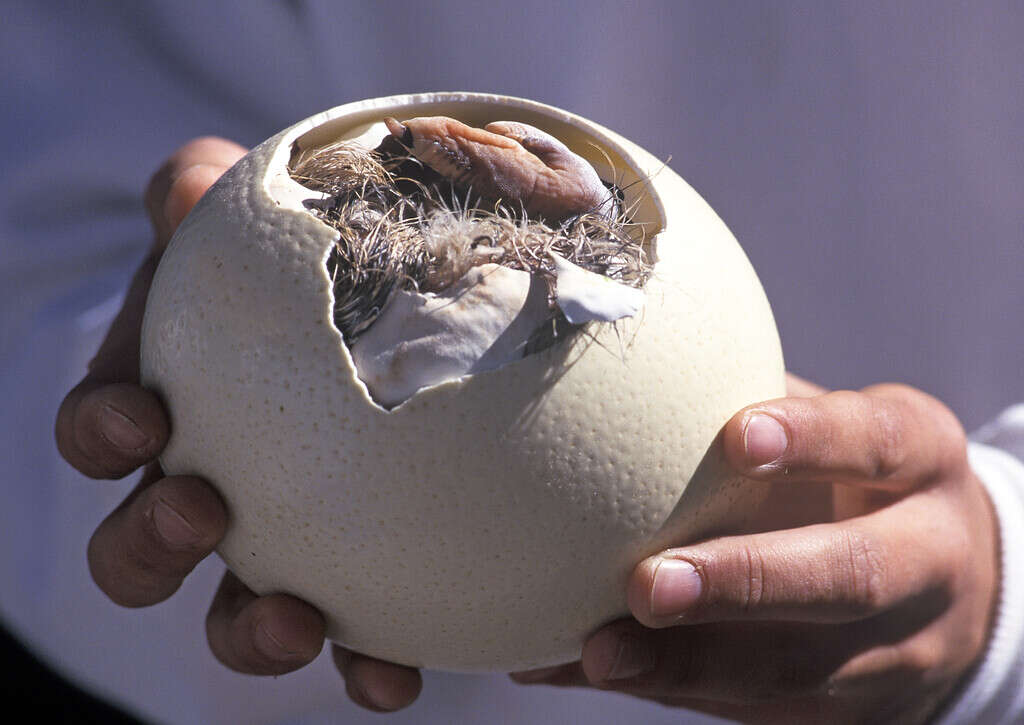
An ostrich egg weighs an average of only about 1.5% of its mother, the smallest egg-to-adult ratio in the bird world.
©John Carnemolla/iStock via Getty Images
Ostrich eggs are an average of 15.9 cm (6.3 in) long, 13 cm (5.1 in) long, and weigh 1.4 kg (3.1 lbs). Meanwhile, adult female ostriches are an average of 1.75 – 1.90 m (5.7 – 6.2 ft) tall and weigh 90 – 110 kg (198 – 243 lbs). Males are even bigger, growing 2.10 – 2.75 m (6.9 – 9.0 ft) tall and weighing 100 – 156 kg (200 – 344 lbs).
2. Ostrich nests contain eggs from multiple females.
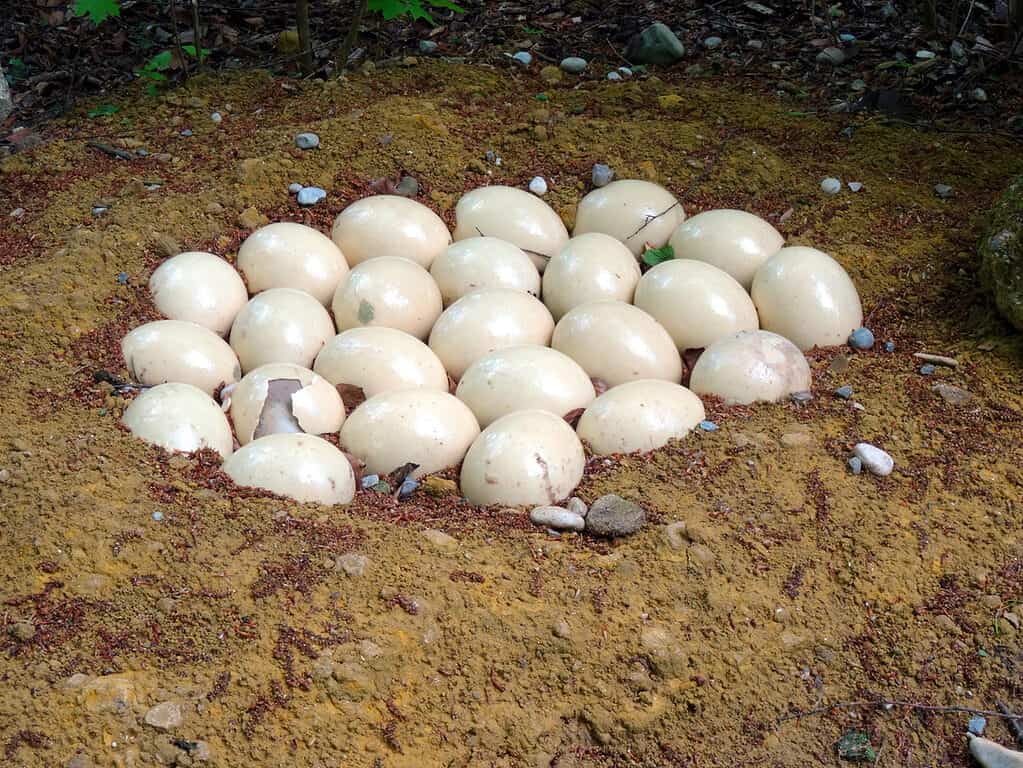
Ostriches lay their eggs in a shallow ground scrape nest.
©iStock.com/Nicki1982
Wild ostriches utilize communal nests in a territory guarded by a dominant male. The dominant female will lay her clutch first, usually 7 – 10 eggs, then the secondary females will lay additional eggs. Nests can sometimes end up with over 40 eggs laid in them, but the dominant female will whittle this down to a more manageable 20 – 25 eggs.
3. The dominant male and female ostrich pair share incubation duties.
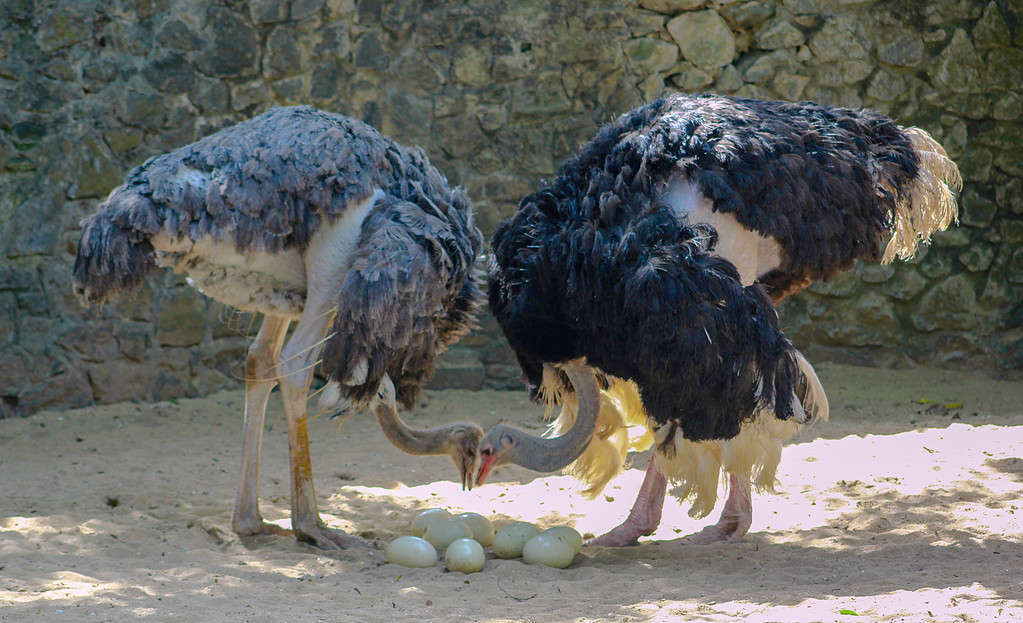
Ostrich eggs are incubated for about 42 – 46 days.
©Shakeel Sha/iStock via Getty Images
The female typically incubates during the day, while the male incubates at night. This same pair then works together to raise the chicks.
4. Baby ostriches are born to run.
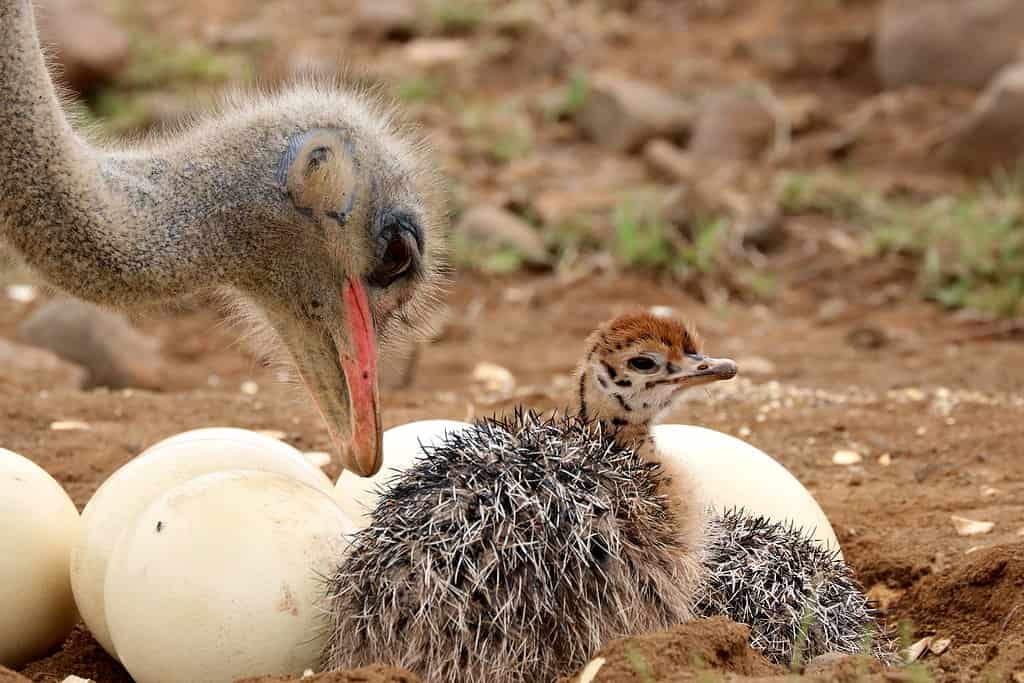
Ostrich chicks are born with a well-developed coat of down feathers.
©thula-photography/iStock via Getty Images
Ostrich chicks are born precocial – that is, they are born fully feathered and with eyes open. They are also able to eat and move on their own soon after hatching.
5. Ostrich chicks have plumage designed for camouflage.
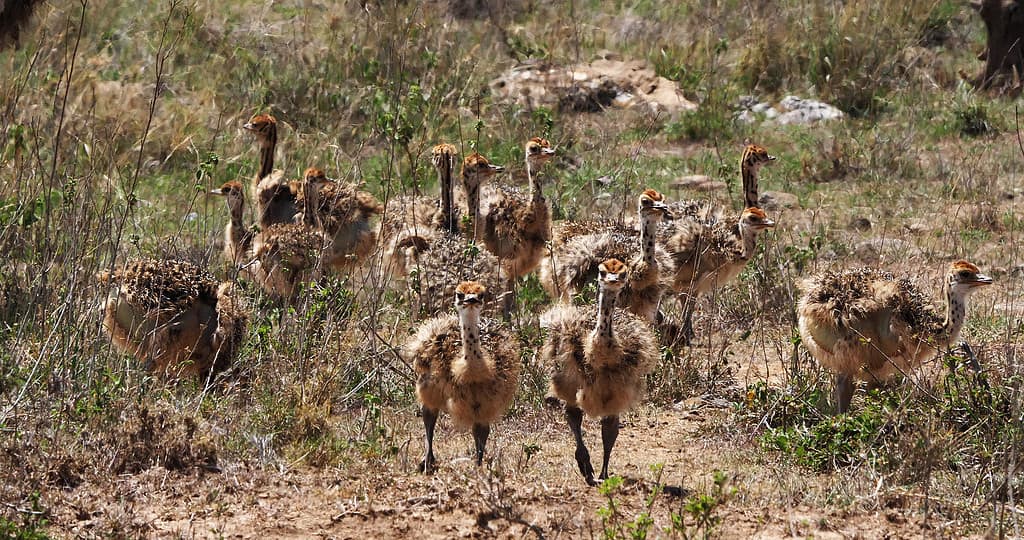
Camouflage-colored plumage helps keep baby ostriches safe from predators.
©slowmotiongli/iStock via Getty Images
Ostrich chicks have buff-colored down feathers marked with dark lines and specks, which help them blend into the groundscape.
6. Ostrich chicks leave the nest 3 -5 days after hatching.

©Duncan Noakes/iStock via Getty Images
Although baby ostriches can move around soon after birth, they will remain together in the nesting area for the first few days under the watchful eye of their parents. However, they will soon be ready to leave with them and begin to explore their world!
7. Ostrich chicks stay in family groups for up to their first year of life.
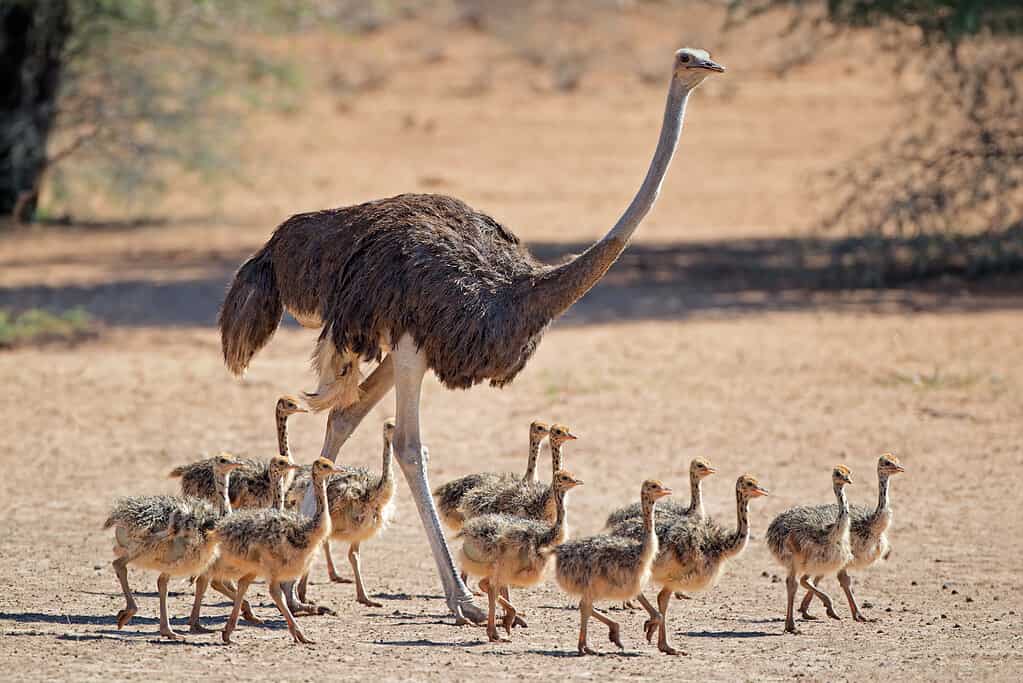
An adult ostrich caring for a brood of chicks may be either a biological or adoptive parent.
©EcoPic/iStock via Getty Images
While broods may start with the dominant male and female parents who hatched them, they often end up in looser organized crèches. Sometimes, when two or more family groups come in contact, the brood from one group may end up going off with another; resulting in some pairs caring for well over a hundred chicks!
8. Ostrich chicks can use an adult’s shadow to stay cool.

Baby ostriches can use mom or dad as a sun umbrella when needed.
©Massimo_S8/iStock via Getty Images
One advantage of having such large parents is that their bodies cast big shadows, which chicks use to take shelter from the scorching sun.
9. Ostriches reach sexual maturity between 2 – 4 years old.
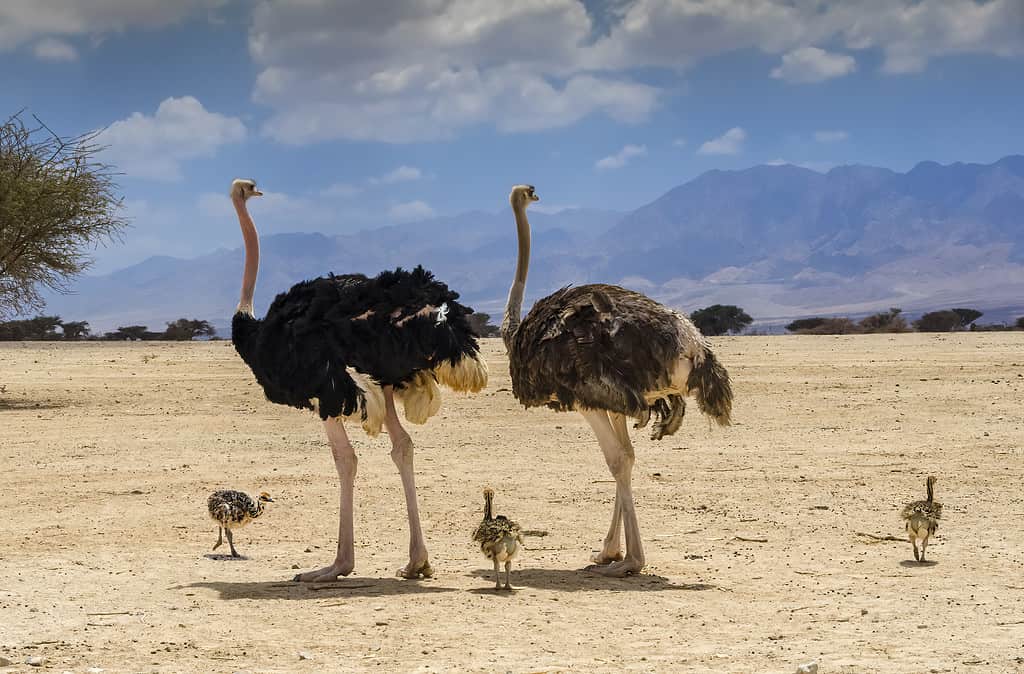
While baby ostriches look alike, adult males and females have distinct plumage colors.
©gorsh13/iStock via Getty Images
Male and female ostriches develop sexual dimorphism as adults, with males displaying black and white plumage and females with duller brown. Female ostriches reach sexual maturity about six months earlier than males on average.
10. Ostriches are long-lived birds.

As adults, ostriches are the world’s largest living birds.
©feel4nature/iStock via Getty Images
Due to high predation rates, only about 15% of wild ostrich chicks survive their first year of life. However, for those who make it to adulthood, their life span is estimated to be about 30 – 40 years in the wild. Ostriches in captivity can reportedly live for up to 70 years!
Summary
Ostrich eggs are the largest in the bird world, though in proportion to the mother, they are the smallest. Ostrich nests may contain over 20 eggs laid by multiple females, but only the dominant female and male incubate them. The eggs hatch after about 42 – 46 days. The chicks are born well-developed (precocial) and leave the nest with their parents after a few days, with their brown mottled plumage providing camouflage. They will stay in family groups for up to their first year of life, and reach full maturity between 3 – 4 years old. Ostriches may live 30 – 40 years in the wild and up to 70 years in captivity.
The photo featured at the top of this post is © thula-photography/iStock via Getty Images
Thank you for reading! Have some feedback for us? Contact the AZ Animals editorial team.






